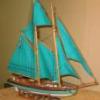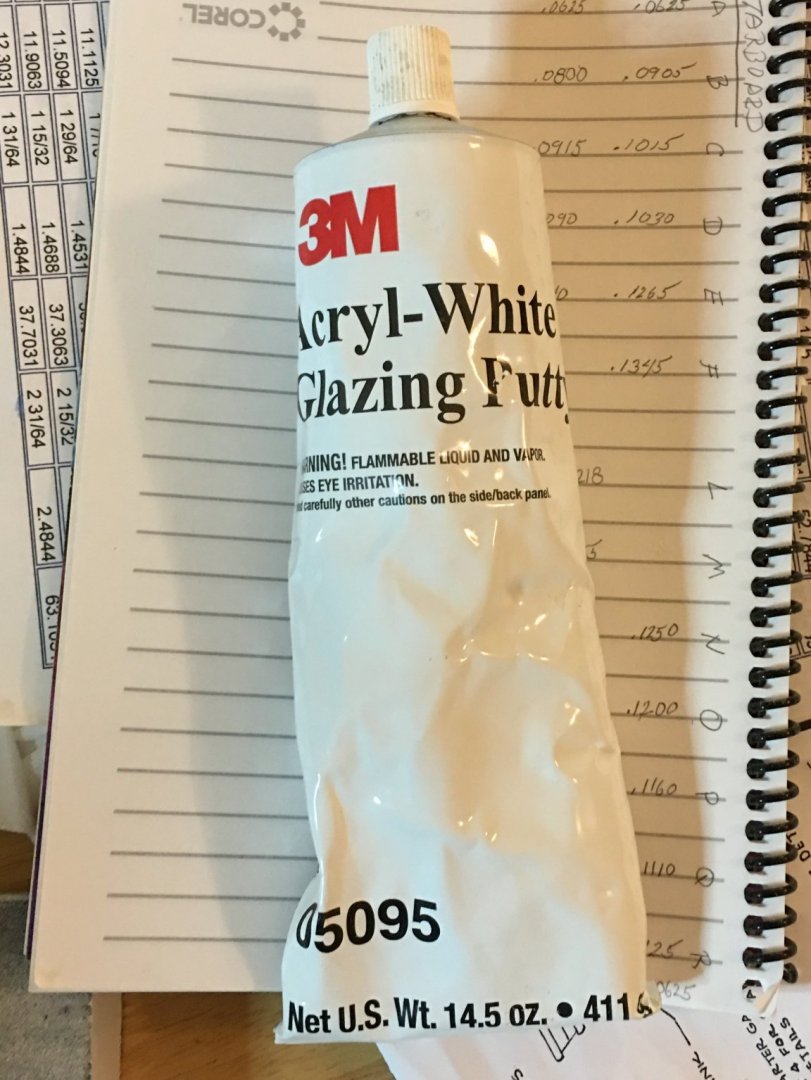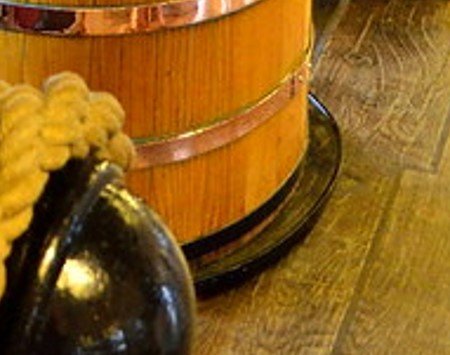-
Posts
2,609 -
Joined
-
Last visited
Content Type
Profiles
Forums
Gallery
Events
Everything posted by JSGerson
-
The stuff sets up in about 30 minutes, but I would wait as a minimum of four or more hours just to be sure. It becomes hard but easy to sand. Then the areas were scraped and sanded. Because the putty shrinks slightly upon hardening, I used more than one coat in many areas and repeated the process and repeated again till satisfied. Here are the instruments of removal: scrapers, sanding sticks, files, and a sponge sanding block.
-
The last hull plank has been installed. As I’ve mentioned before, this is only my second hull planking and it’s a lot better than my first (Rattlesnake). Here at least I think I knew what had to done. I came close but there was a bit more stealer joints used than I had planned for. A fine model builder and kit designer, Chuck Passaro once said that if you plan the planks right, you won’t need any stealers. Well, I needed them. That’s all a moot point because the hull has to be sanded, touched up to fill some voids, sealed, and prepped for copper plating, and painting, which will cover the planking imperfections from the critical eye.
-
No problem posting a link to my log. I kinda wish you would maintain your log. Seeing how other builders deal with problems and the solutions they come up with is the main reason I read everyone else's logs. If it's real time (as opposed to milestones), we the readers, can offer immediate solutions or even better, prevent you from making mistakes. I've learn so much that way. Still, I look forward to all your future posts.
-
Nice recovery on the planking; it's looking great now. What's better, is that the black paint and copper plating will completely cover up the planking lines and no one will ever know. I noticed that the bottom of the wale has not been blended into hull yet. Were you planning on doing that after the hull planking is completed? I did mine as I was it stalling it. My hull is almost fully planked. I've got about three rows left on the starboard side.
-
You are moving right along, much faster than me. Looking at your third picture (the full hull upside down), it appeared to me that your strakes have a wave, dipping towards the keel and then rising again. You might want to verify the width calculations of you planks so that when you get to the keel, it's nice and straight. As I was planking the belts on my model, I recalculated the plank widths each time I started a new belt. They did change a bit due to how well I made the planks and installed them.
-
I’m just a little ahead of you in my planking attempt of my Conny. I didn’t have much luck (or skill?) using the proportional dividers. I could never get them lock with the center screw knob once I took a measurement. The arms moved too easily. I could not convince myself that proportional measurement was accurate, but that’s another story. Instead, I worked with the five-plank band as described by Mr. Hunt, temporarily laying the fifth plank and marking the line it created as it wrapped around the hull. Then at each bulkhead I measured the distance from the last plank laid in the previous band to the line and divide by 5 and recorded the width. I did this for each bulkhead. On each plank, I marked where the bulkhead was and using a micrometer and sandpaper, each plank was sanded to its proper width at every bulkhead position. The dividers would have made it much easier, but I just couldn’t get a consistent result. I will be glad when this portion is finished. Or course there is the copper plating, the cannons and their rigging… 8-)
-
Beautiful model and case. Mine should look as good when I'm done. Out of curiosity, what are the dimension of the case?
- 55 replies
-
- constitution
- model shipways
-
(and 1 more)
Tagged with:
-
Looking very nice. You might want to consider looking at Ken Foran's Constitution build. He is a professional model builder and kit designer. He created the Model Shipways cross-section kit of the Constitution with very impressive instructions. With your skills, you should be able to do many of his techniques with ease.
-
Hull Planking Continued The stanchions made from music wire for the ladders going down below the gun deck, were all knocked off over time due to the manipulation of the hull in the building process. They could not be fastened strongly enough due the very small contact surface area between the music wire and the ladders. Should they get knocked off again, which is probably likely, repairing them would be difficult especially once the hull planking gets below the gun deck level. Therefore, once I decided this detail had to be sacrificed, they were permanently removed. Now I was free to work once again planking the hull without fear of future repairs. This is only my second attempt at planking a hull, the first was the Rattlesnake. So, I’m going to take my time and hopefully avoid too many screw-ups. Following the instructions of Robert Hunt’s practicum, 7+ bands of five planks width each at midship position were laid out, tapering as required as they were extended to the bow and stern. Contrary to Mr. Hunt’s process of planking one side completely and then doing the other, I am alternating side to side as the bands are planked. Additionally, Mr. Hunt worked straight down from top to bottom, I other hand will work a top band first then alternate with a bottom band meeting in the middle. Should any corrections be required, I hope they will be easier in the middle somewhere rather than at the bottom where I believe it might be more difficult to correct. The first band has been completed. I can already see that a lot of sanding and some filler is going to be required. Thank goodness the hull is going to be painted and will hide most of my poor planking techniques. This gives me a greater appreciation to those builders who can do this cleanly and without any paint.
-
Just found your log. Your build looks great to me. I too am following Mr. Hunt's practicum and is also only my second BOF so we have a lot in common. I look forward to your progress. I can't answer your questions about paints and primers, all I can do is point you towards xKen's build. He a superb model builder and did a great job with his paint job on his Conny. He also recommends that you fill in all the nooks and crannies with wood filler and sand smooth to prime the surface for the copper plating. The smoother the better. Bare wood is not a good surface.
-

Model Shipways USS Constitution Cross Section
JSGerson replied to Jorge Hedges's topic in Wood ship model kits
I just took a look at the Model Shipways USS Constitution Cross Section instruction booklet that is downloadable. This was written by Ken Foran, a superb master model builder. Take a look at his build log of his full Model Shipways build. This photo illustrated instruction booklet has great detail and a lot can be applied to the full version of the model. I wish he had written one for the full version as well. Now that I know this instruction booklet exists, I’ll be using many of the techniques show there on my build of the full ship. -
Here are the three items in dry fit position on the gun deck along with all the other components. At this point I am entertaining various scenarios as to which areas to work on next. I’m reluctant to install anything permanent on the gun deck yet because I haven’t fabricated the quarter galleries, or for that matter finished the hull itself. I had thought I might close in the gun deck to get to the spar deck and get in sync with the practicum which did not address the gun deck interior. But I fear the manipulation of the hull for planking, coppering, etc. might damage the delicate items on the gun deck. As it is, the gun deck ladder stanchions all have to be fixed. We’ll see.
-
The Grog Tub and Table I had no plans for either the grog tub or its table. This was strictly eyeball stuff based on pictures. Constructed like the harness cask, I used a piece of 3/8” x 3/8” x 3/8” boxwood and shaped it. The lid was a separate piece. I took my best shot carving the lid handle, but I think its too big. I just couldn’t make it any smaller
-
The last bit of the cask was its base. I noticed that this cask sat in a pan for some reason. The base of the pan was carved from 1/64 spruce plywood. The rim was a strip of card stock CA’d to the plywood. To do this, the plywood was lying on a piece of wax paper while I liberality applied the CA as I worked my way around the plywood edge. The card stock soaked up the glue which gave it stiffness. The wax paper easily peeled off the construct. The pan was painted flat black. The pan in turn sat on two layers of dunnage which was a few pieces of scrap wood and stained.
About us
Modelshipworld - Advancing Ship Modeling through Research
SSL Secured
Your security is important for us so this Website is SSL-Secured
NRG Mailing Address
Nautical Research Guild
237 South Lincoln Street
Westmont IL, 60559-1917
Model Ship World ® and the MSW logo are Registered Trademarks, and belong to the Nautical Research Guild (United States Patent and Trademark Office: No. 6,929,264 & No. 6,929,274, registered Dec. 20, 2022)
Helpful Links
About the NRG
If you enjoy building ship models that are historically accurate as well as beautiful, then The Nautical Research Guild (NRG) is just right for you.
The Guild is a non-profit educational organization whose mission is to “Advance Ship Modeling Through Research”. We provide support to our members in their efforts to raise the quality of their model ships.
The Nautical Research Guild has published our world-renowned quarterly magazine, The Nautical Research Journal, since 1955. The pages of the Journal are full of articles by accomplished ship modelers who show you how they create those exquisite details on their models, and by maritime historians who show you the correct details to build. The Journal is available in both print and digital editions. Go to the NRG web site (www.thenrg.org) to download a complimentary digital copy of the Journal. The NRG also publishes plan sets, books and compilations of back issues of the Journal and the former Ships in Scale and Model Ship Builder magazines.





